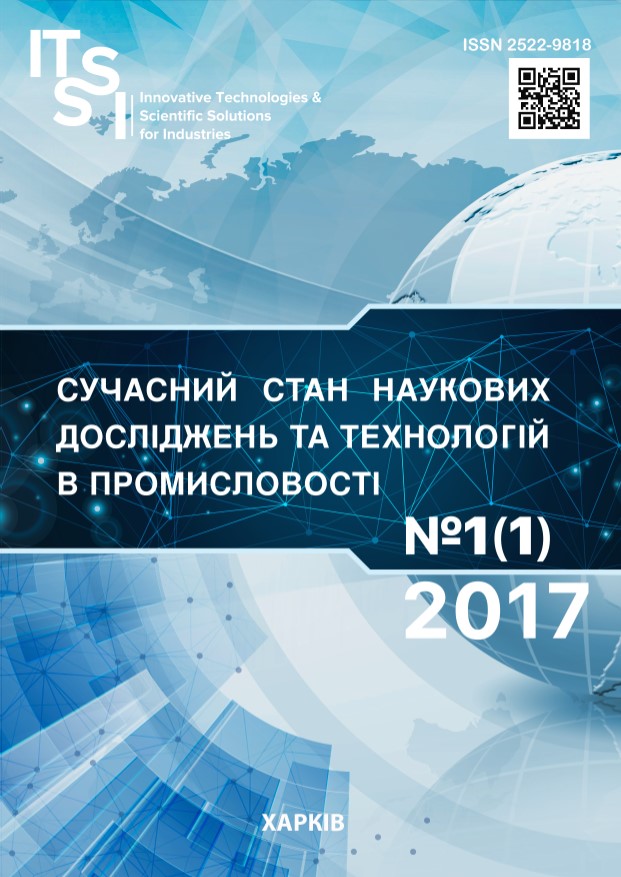ІНФОРМАЦІЙНА ТЕХНОЛОГІЯ ПЛАНУВАННЯ ЕНЕРГОЗАБЕЗПЕЧЕННЯ БУДІВЕЛЬ З ВІДНОВЛЮВАЛЬНИМИ ДЖЕРЕЛАМИ ЕНЕРГІЇ
DOI:
https://doi.org/10.30837/2522-9818.2017.1.090Ключові слова:
інформаційна технологія, задача планування енергозабезпечення будівель, відновлювальні джерела енергії, система підтримки прийняття рішеньАнотація
Одним із способів реалізації політики енергоефективності є розробка і впровадження енергозберігаючих технологій шляхом збільшення частки використання відновлювальних джерел енергії. Енергозабезпечення залежить від наявності акумуляторних батарей, сонячних панелей, вітрогенераторів та їх комбінації у структурі енергосистеми, що забезпечує споживання в господарстві. При побудові максимально ефективної енергосистеми, необхідно оперувати великою кількістю розрізнених даних про потенціал енергоресурсу в конкретній місцевості, варіанти складових частин системи, можливість сполучення з іншими регіональними мережами з урахуванням зовнішніх умов (мінливі погодні дані, пори року, пропускні потужності мереж, та ін.). Крім того, рішення залежать також від суб'єктивних чинників, які повинні бути ідентифіковані і включені в процес планування. Тому процес планування енергозабезпечення будівель з відновлювальними джерелами енергії потребує створення інформаційних систем підтримки прийняття рішень, які надають рекомендації щодо вибору складових енергоситеми. Предметом даного дослідження є інформаційна технологія планування енергозабезпечення будівель з відновлюваними джерелами енергії. Метою даної роботи підвищення ефективності рішень при плануванні структури енергосистеми за рахунок створення інформаційної системи для підтримки прийняття рішень. Задачами дослідження є побудува інформаційної технології, моделювання процесів, що протікають при плануванні структури енергосистеми, проектування архітектури відповідної інформаційної системи. Під час розв’язання поставлених задач було використано методологію системного аналізу для формалізації процедури планування енергетичної системи та методи структурного аналізу і функціонального моделювання інформаційних систем для побудови структурно-функціональних моделей процесу планування. Для реалізації запропонованої та інформаційної технології підтримки прийняття рішень при плануванні енергозабезпечення будівель розроблено систему підтримки прийняття рішень, що реалізована у вигляді програмного веб додатку із трьохрівневою клієнт-серверною архітектурою. Використання системи підтримки прийняття рішень дозволяє підвищити ефективність прийняття рішень при плануванні енергозабезпечення будівель з використання відновлювальних джерел енергії.Посилання
Krasnyanskiy, M. (2006), "Energy Security of Mankind in The XXI Century", Energy, Industry, Regions, Vol. 1, pp. 156-167.
Sabirzianov, T. H., Kubkin, M. V., Soldatenko, V. P. (2011), "Methodology for selecting the structure and composition of power supply systems with renewable sources", Collection of scientific works of the Kirovohrad national technical university. Engineering in agricultural production, branch engineering, automation ["Metodyka vyboru struktury i skladu system elektropostachannia z vidnovliuvalnymy dzherelamy, Zbirnyk naukovykh prats Kirovohradskoho natsionalnoho tekhnichnoho universytetu. Tekhnika v silskohospodarskomu vyrobnytstvi, haluzeve mashynobuduvannia, avtomatyzatsiia"], Vol. 24, pp. 146-151.
Kubkin, M. V., Soldatenko, V. P. (2012), "Simulation model of a combined power system with renewable energy sources", Collection of scientific works of the Kirovohrad national technical university. Engineering in agricultural production, branch engineering, automation ["Imitatsiina model kombinovanoi elektroenerhetychnoi systemy z vidnovliuvanymy dzherelamy enerhii", Zbirnyk naukovykh prats Kirovohradskoho natsionalnoho tekhnichnoho universytetu. Tekhnika v silskohospodarskomu vyrobnytstvi, haluzeve mashynobuduvannia, avtomatyzatsiia], Vol. 2. pp. 192-202.
Tiba, C., Candeias, A. L. B., Fraidenraich, N., de Barbosa E. M, de Carvalho Neto, P. B., de Melo Filho, J. B. (2010), "A GIS-based decision support tool for renewable energy management and planning in semi-arid rural environments of northeast of Brazil", Renewable Energy, Vol. 35, pp. 2921-2932.
Yi, Ch-S, Lee, J-H, Shim, M-P (2010), "Site location analysis for small hydropower using geo-spatial information system", Renewable Energy, Vol. 35, pp. 852-861.
Lazarou, S., Oikonomou, D. S., Ekonomou, L. (2012), "A platform for Planning and Evaluating Distributed Generation connected to the Hellenic Electric Distribution Grid", Advances in Circuits, Systems, Automation and Mechanics, pp. 80-86.
Ramachandra, T. V. (2009), "RIEP: Regional integrated energy plan", Renew Sustain Energy Rev, Vol. 13, pp. 285–317.
Shulyma, O. V., Shendryk, V. V., Davidson, P. (2016), "Formalization of the decision making problem for choosing the optimal structure of the hybrid power system", Bulletin of the National Technical University "KhPI". Series: Mechanic-technological systems and complexes ["Formalizatsiia zadachi pryiniattia rishen dlia vyboru optymalnoi struktury hibrydnoi enerhetychnoi systemy", Visnyk Natsionalnoho tekhnichnoho universytetu "KhPI". Seriia: Mekhaniko-tekhnolohichni systemy ta kompleksy], Vol. 49, pp. 62-69.
Christopher, M., Mayer, R. J., Bernus, P. (ed), Mertins, K. (ed), Schmidt, G. (ed) (1998), "The IDEF Family of Languages", Handbook on Architectures of Information Systems, Springer Berlin Heidelberg, Berlin, pp. 215–249.
Vendrov, A. M. (1998), Case - technology. Modern methods and means of designing information systems [Case – tehnologii. Sovremennye metody i sredstva proektirovanija informacionnyh sistem], Finansy i statistika, Moscow, 176 p.
Shulyma, O. V., Shendryk, V. V., Shestak, M. O. (2016), "Building a data storage for a decision support system for the design of distributed power systems", Proceedings of the National University "Lviv Polytechnic" ["Pobudova skhovyshcha danykh systemy pidtrymky pryiniattia rishen dlia proektuvannia rozpodilenykh enerhetychnykh system", Visnyk Natsionalnoho universytetu "Lvivska Politekhnika". Informatsiini systemy ta merezhi], Vol. 854, pp. 291-298.
##submission.downloads##
Як цитувати
Номер
Розділ
Ліцензія
Авторське право (c) 2018 Ольга Василівна Шулима

Ця робота ліцензується відповідно до Creative Commons Attribution-NonCommercial-ShareAlike 4.0 International License.
Наше видання використовує положення про авторські права Creative Commons для журналів відкритого доступу.
Автори, які публікуються у цьому журналі, погоджуються з наступними умовами:
Автори залишають за собою право на авторство своєї роботи та передають журналу право першої публікації цієї роботи на умовах ліцензії Creative Commons Attribution-NonCommercial-ShareAlike 4.0 International License (CC BY-NC-SA 4.0), котра дозволяє іншим особам вільно розповсюджувати опубліковану роботу з обов'язковим посиланням на авторів оригінальної роботи та першу публікацію роботи у цьому журналі.
Автори мають право укладати самостійні додаткові угоди щодо не комерційного та не ексклюзивного розповсюдження роботи у тому вигляді, в якому вона була опублікована цим журналом (наприклад, розміщувати роботу в електронному сховищі установи або публікувати у складі монографії), за умови збереження посилання на першу публікацію роботи у цьому журналі.
Політика журналу дозволяє і заохочує розміщення авторами в мережі Інтернет (наприклад, у сховищах установ або на особистих веб-сайтах) рукопису опублікованої роботи, оскільки це сприяє виникненню продуктивної наукової дискусії та позитивно позначається на оперативності та динаміці цитування опублікованої роботи.














